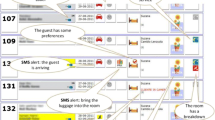Abstract
The purpose of this research is to propose an efficient management scheme for Virtual Personal World (VPW) which is a model focused on service continuity of personal world. Previous ubiquitous frameworks have been concerned with where is the user is serviced and what services can be offered in that space. However those questions above are not the most important problems anymore in VPW. We also introduce a management scheme for the real world object based on the concept of Virtual Objects (VO). As users can use some services unique way with various VOs, VPW framework creates User-Generated services automatically. It helps users to satisfy their specific personalized services. Our proposed manage scheme of user-generated service increases generation of service about seven times than a scheme without generation. Consequently, we find generated services encourage user satisfaction. We simulate the possibility that a user takes proper service which is not needed generation newly.










Similar content being viewed by others
References
El-Khatib, K., Zhang, Z., Hadibi, N., & Bochmann, G. (2004). Personal and service mobility in ubiquitous computing environments. Wireless Communications and Mobile Computing, 4, 595–607.
Fan, Z., & Ho, E. G. (2007). Service discovery in ad hoc networks: Performance evaluation and QoS enhancement. Wireless Personal Communications, 40(2), 215–231.
Harter, A., Hopper, A., Steggles, P., Ward, A., & Webster, P. (2002). The anatomy of a context-aware application. Wireless Networks, 8, 187–197.
Li, B. (2002). On increasing service accessibility and efficiency in wireless ad-hoc networks with group mobility. Wireless Personal Communications, 21(1), 105–123.
Mori, G., Paterno, F., & Santoro, C. (2004). Design and development of multidevice user interfaces through multiple logical descriptions. IEEE Transactions on Software Enginering, 30(8), 507–520.
Rajkumar, R., Lee, C., Lehoczky, J., & Siewiorek, D. (1997). A resource allocation model for QoS management. In Proceedings of the 18th real-time systems symposium, pp. 298–307.
Roman, M., Hess, C., Cerqueira, R., Ranganathan, A., Campbell, R. H., & Nahrstedt, K. (2002). Gaia: A middleware infrastructure to enable active spaces. IEEE Pervasive Computing Magazine, 1(4), 74–82.
Singh, M. P., & Huhns, M. N. (2005). Service-oriented computing semantics, processes, agents. Berlin: Wiley.
Sousa, J. P., & Garlan, D. (2002). Aura: An architectural framework for user mobility in ubiquitous computing environments. In Proceedings of the3rd workshop IEEE/IFIP conference on software architecture, pp. 29–43.
Weiser, M. (1991). The computer for the 21st century. Scientific American, 265(3), 66–75.
Weiser, M. (1993). Some computer science issues in ubiquitous computing. Communications of the ACM, 36(7), 75–84.
Yang, C.-S., Lu, Y.-C., Liao, M.-Y., & Chen, C.-X. (2011). Design and implementation of HEMS based on RFID and OSGi. Wireless Personal Communications, 59(1), 73–83.
Yazidi, A., Granmo, O.-C., Oommen, B. J., Gerdes, M., & Reichert, F. (2011). A user-centric approach for personalized service provisioning in pervasive environments. Wireless Personal Communications, 61(3), 543–566.
Acknowledgments
This work was supported by Basic Science Research Program through the National Research Foundation of Korea (NRF) funded by the Ministry of Education, Science and Technology (MEST) (2012081659).
Author information
Authors and Affiliations
Corresponding author
Rights and permissions
About this article
Cite this article
Hong, CP., Kim, CG. & Kim, SD. An Effective Personalized Service Provision Scheme Based on Virtual Space for Ubiquitous Computing Environment. Wireless Pers Commun 73, 275–288 (2013). https://doi.org/10.1007/s11277-013-1236-3
Published:
Issue Date:
DOI: https://doi.org/10.1007/s11277-013-1236-3




